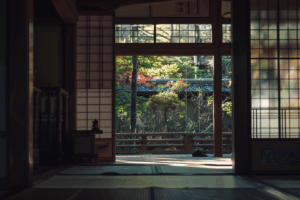In a world that’s increasingly complex, fast-paced, and digitally dominated, there’s a growing hunger for something different: simplicity, meaning, and genuine connection. Perhaps that’s why so many global leaders, entrepreneurs, and creatives are turning to Japan’s ancient spiritual traditions for inspiration.
What makes Japanese spiritual practices so appealing isn’t their exoticism—it’s their practicality. For centuries, Buddhist and Shinto principles haven’t been relegated to temples or special occasions; they’ve been seamlessly woven into everyday Japanese life. This integration has created customs and habits that foster mindfulness, harmony, and resilience—precisely the qualities we need to thrive in today’s world.
Let’s explore how these age-old Japanese traditions can be applied to modern lives and businesses, offering practical wisdom for anyone seeking balance in a chaotic time.
The Power of Transitional Moments: Lessons from Torii Gates
In Japanese Shinto practice, torii gates mark the transition from the ordinary world to sacred space. As you pass through these iconic red gates at the entrance to a shrine, you’re prompted to shift your awareness and prepare for something meaningful.
Modern Application: Create intentional transitions in your day. Before beginning work, establish a brief ritual that signals to your brain it’s time to focus—perhaps a moment of silence, a specific hand gesture, or arranging your workspace in a particular way. Tech leaders at companies like Google and Apple have adopted similar “mindful transitions” between meetings and tasks, reporting improved focus and reduced stress.
Try This Today: Set up a small object on your desk that represents your own personal “torii gate.” Touch it briefly before starting important work as a reminder to bring your full presence to the task.
Finding Clarity Through Emptiness: Ma and Strategic Pauses
The Japanese concept of ma (間) refers to negative space or interval—the powerful emptiness between objects, notes, or words. In traditional Japanese arts, from garden design to calligraphy, these deliberate “empty” spaces aren’t lacking—they’re purposeful, allowing the essential elements to breathe and communicate more clearly.
Modern Application: Strategic pauses in business and personal life create space for innovation and authentic connection. Leading companies now incorporate “digital detox” periods or meeting-free days to allow for deeper thinking. The empty spaces in your calendar might become your most productive moments.
Try This Today: Identify one recurring meeting or social media check-in you can eliminate this week. Use that time for unstructured thinking or reflection instead.
Daily Mindfulness: The Way of Ohenro in Modern Steps
The Ohenro pilgrimage on Shikoku Island involves visiting 88 temples, with each step becoming a meditation. Traditionally taking weeks or months, this practice teaches that spiritual growth happens through consistent, mindful action—not dramatic gestures.
Modern Application: Break large goals into daily practices that become rituals. Instead of aiming for overnight transformation, successful entrepreneurs and wellness experts recommend identifying “minimum viable habits” that can be sustained consistently. Making small, mindful choices each day creates remarkable long-term results.
Try This Today: Choose one small action related to your biggest goal that you can do daily for just five minutes. Approach it with the same reverence a pilgrim would bring to visiting a temple.
Embracing Impermanence: Mono no Aware in Business and Life
The Buddhist-influenced concept of mono no aware (物の哀れ) describes the poignant awareness of life’s transience. Rather than creating sadness, this recognition of impermanence allows for deeper appreciation of beauty and heightened presence—as seen in the Japanese celebration of cherry blossoms, whose fleeting nature makes them more precious.
Modern Application: In rapidly changing industries, companies that embrace impermanence often adapt more successfully than those clinging to outdated models. On a personal level, acknowledging that nothing lasts forever—including challenging situations—builds resilience. Leading venture capitalists now actively seek entrepreneurs who demonstrate this “change-positive mindset.”
Try This Today: Identify something you’re resistant to changing. Ask yourself: “If I embraced this change as natural and inevitable, like the seasons, how might my approach differ?”
Finding Balance Through Ritual: Cha-no-yu Principles
The Japanese tea ceremony (cha-no-yu) transforms a simple act—drinking tea—into a profound practice through four principles: harmony (和, wa), respect (敬, kei), purity (清, sei), and tranquility (寂, jaku).
Modern Application: Create “ritual zones” in your day where ordinary activities become opportunities for mindfulness. Many successful business leaders have adopted personal rituals—from morning journaling to evening reflection—that embody these four principles. When approached with intention, even checking email can become a meaningful practice rather than a mindless habit.
Try This Today: Choose one routine activity (your morning coffee, your commute, your first check of messages) and redesign it as a mindful ritual using the four principles of the tea ceremony.
Kaizen: The Buddhist Path of Continuous Improvement
Though now famous as a business philosophy, kaizen (改善, “continuous improvement”) has roots in Buddhist practice, where the path to enlightenment is seen as gradual refinement rather than sudden transformation.
Modern Application: Rather than pursuing dramatic reinventions, focus on small, consistent improvements in key areas. Leading tech and manufacturing companies have found that small, daily improvements compound more effectively than grand initiatives. This approach reduces resistance to change and builds sustainable progress.
Try This Today: Identify one area of your work or life where you’ve been waiting for a “big breakthrough.” What is the smallest possible improvement you could make in that area today?
Gratitude Practice: The Daily Itadakimasu
Before meals, Japanese people say “itadakimasu” (いただきます)—a phrase expressing gratitude not just for the food, but for everyone and everything involved in bringing it to the table. This brief ritual creates a moment of connection and awareness.
Modern Application: Regular gratitude practices have been scientifically shown to improve mental health, sleep quality, and interpersonal relationships. Forward-thinking organizations are incorporating structured appreciation into their cultures, from dedicated Slack channels for peer recognition to beginning meetings with expressions of gratitude.
Try This Today: Before your next meal or meeting, take 10 seconds to mentally acknowledge all the people whose efforts made it possible—from farmers to coworkers.
The Path Forward: Integration, Not Imitation
The value in these Japanese spiritual practices isn’t in copying their external forms, but in understanding the principles they embody and thoughtfully integrating them into your own context. The most successful adaptations honor the spirit of these traditions while making them relevant to contemporary challenges.
As you explore these practices, remember that in Buddhist tradition, wisdom isn’t something you acquire—it’s something you uncover within yourself through patient, consistent practice. The Japanese approach suggests that true transformation doesn’t come from dramatic reinvention, but from bringing greater awareness to the ordinary moments that make up your day.
Which of these practices resonates most with you? How might you begin to incorporate it into your daily life? The ancient wisdom of Japan offers not a destination, but a path—one that begins with a single, mindful step.


